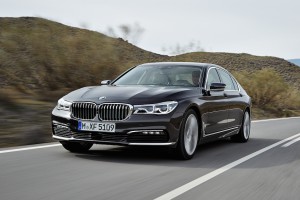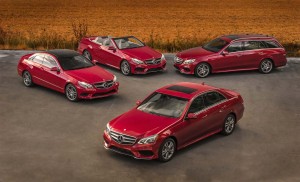The next-generation Mercedes-Benz E-Class line, set to debut in Detroit next January, will take “another big step” closer to full autonomous driving, a senior company source tells TheDetroitBureau.com.
Among other things, the midsize model will be able to drive down a freeway hands-free, while also handling low-speed, stop-and-go traffic all but fully autonomously.
“It’s definitely going a step ahead” of what is currently offered by any vehicle on the road, said the Mercedes executive, who asked not to be identified by name. Several other Mercedes insiders confirmed the plans for the new E-Class line, which will be unveiled at the North American International Auto Show in Detroit in January, with sales set to begin a few months later.
For the Stuttgart-based automaker, the E-Class is being seen as a point of pride. Insiders promise it will offer all the autonomous driving and high-tech safety features of the all-new, and much more expensive BMW 7-Series.
(Jaguar Land Rover developing app allowing a motorist to control a vehicle remotely via smartphone app. Click Here for more.)
That underscores the rapid advances in digital technology the auto industry is loading into its newest products. It’s been less than two decades since vehicles like the Mercedes S-Class first introduced radar-guided cruise control technology capable of adjusting a vehicle’s speed to maintain a safe distance in traffic. The latest S-Class now can come to a complete stop, if needed, whether due to heavy traffic or to avoid a collision with another vehicle.

Mercedes promises the new E-Class will feature all the semi-autonomous tech of the next-gen BMW 7-Series.
But that and most of the other high-tech features introduced on the latest S-Class in 2013 have now migrated down to the much more affordable Mercedes C-Class. And forward collision warning with brake intervention has become increasingly common on mainstream vehicles, such as the new Mitsubishi Outlander SUV starting at barely $22,000.
“Innovations in this area are coming thick and fast,” Thomas Weber, head of development for Mercedes’ parent, Daimler AG, recently told the Bloomberg news service. “While we don’t want to feed wrong expectations such as sleeping in the car, autonomous driving is set to become a reality much more quickly than the public thinks.”
That said, most automakers, including Mercedes, plan to phase in autonomous technologies, step-by-step, between now and the early part of the next decade. The S- and C-Class models allow a driver to lift their hands off the steering wheel for a few seconds, the car using its various radar and camera sensors to maintain its position. In slow traffic, the car can crawl to a stop and then start up again at speeds up to 18 mph.
The E-Class technology will work “quicker, better, faster,” explained the Mercedes executive, and allow a motorist to spend more time with their hands totally off the steering wheel. The system is not expected to allow the vehicle to change lanes, however, something likely to follow in a yet-more advanced version in a couple years.
Other automakers expecting to phase in semi-autonomous features include BMW, as well as Cadillac. The U.S. luxury maker’s SuperDrive system will debut in 2017 on the new CT6 flagship sedan and also allow hands-off freeway driving. Tesla Motors is expected to launch a similar system on its Model S by then, as will Nissan. The Japanese maker has promised to put its first fully autonomous vehicle into production by 2020, though skeptics question whether it can make that target date.
(Click Here for more on the new Cadillac CT6.)
The challenge is to come up with not just the sensors needed to substitute for human eyes and ears, but also to develop the software that can manage the complex decisions a driver must make constantly. It’s one thing to recognize a person crossing the street, for example, but the vehicle also will need to recognize and then know what to do if that pedestrian signals the car to keep going, said the Mercedes executive.
(Autonomous vehicles involved in a number of crashes. Who was at fault? Click Here to find out.)
And while proponents contend it is just a matter of time until the right software code can be written, there will be legal and other obstacles to deal with. Right now, hands-free driving is technically illegal in the U.S. The National Highway Traffic Safety Administration – along with numerous state regulators – is exploring the need to set new autonomous vehicle guidelines.
Mercedes recently unveiled its vision of a fully autonomous future in the form of the F 015 concept vehicle. That show car would allow a motorist to switch to self-driving mode and then swivel their chair to interact with passengers in a lounge-like environment – or to lay back and even take a nap.
Parent Daimler AG’s truck division, meanwhile, last month unveiled the new Freightliner Inspiration concept vehicle. The prototype, 70,000-pound truck would allow hands-free driving on well-marked highways.
Some proponents envision a time when heavy trucks, taxis and even personal use vehicles can operate without a driver onboard at all. Most experts don’t see that coming until closer to mid-century, however.
(Click Here to find out more about the world’s first autonomous truck.)


I suspect with many auto makers rushing to “hands free” driving that they are really searching for answers for AVs. They may be surprised to find their vehicles are not as “hands free” as they had intended when the driver crashes because they were talking or texting instead of watching the road.
You can also bet there will be major lawsuits when computer controlled vehicles do panic stops for no logical reason and the cars behind crash into the “hands free” car in front. In some states if you cause an accident by slamming on the brakes then you are at least 50% responsible under the law.